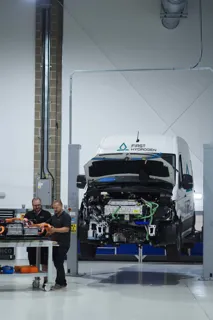Stellantis is scaling up production of the Peugeot Expert, Citroen Dispatch and Vauxhall Vivaro fuel cell light commercial vehicles to an industrial level.
The group has invested in its Hordain plant, in France, giving a production capacity of 5,000 hydrogen-powered vehicles per year, by 2024.
The vans will be built alongside electric and diesel models.
Stellantis CEO Carlos Tavares said: “I’m very proud of the work done by the management and employees at Hordain, who have made their site the first in the world to combine three types of energy, made possible by the flexibility of our manufacturing system. Today’s announcement demonstrates the Stellantis commitment to investing in France in the latest technologies, and to supporting low-carbon mobility based on the ‘One Company” principle’.”
Using a reinforced platform from body-in-white onwards, the hydrogen-powered models will follow the usual stages of paintwork and assembly, on the same production line as combustion engine and electric vehicles, before they enter the new 8,000 square-metre facility that focuses solely on the final tuning.
A dedicated team will install the tank, the additional batteries, and the fuel cell on a production line at the Hordain site that halves the adjustment time compared to the previous small-scale process, where the fuel cell was assembled at a pilot workshop in Rüsselsheim.
The fuel cell vehicles are intended for long-distance fleets who require a longer range, the fastest possible refuelling time (three minutes) and no compromises on payload capacity.
The vehicles can store 4.4Kg of liquid hydrogen in chassis-mounted tanks, while a rechargeable 10.5kWh battery contributes to a total range of 250 miles.























Login to comment
Comments
No comments have been made yet.